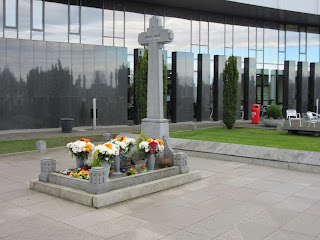The cillín forms part of silent grief which was only really
was discussed within the last years. There is a cillín in every parish, or
rather between every parish, in the country. Many have been erased from the
landscape, while others remain as a silent memory to a less compassionate era.
I have photos of monuments to the cillín in Gone
the Way of Truth. I came across this poem by Derry O'Sullivan while
watching a documentary about the Oileán na Marbh, the island of the dead, which
served as a cillín in Donegal. This poem, written in Irish with an English
translation after it, is about a cillín in Cork.
Saolaíodh id bhás thú
is cóiríodh do ghéaga gorma
ar chróchar beo do mháthar
sreang an imleacáin slán eadraibh
amhail line ghutháin as ord.
Dúirt an sagart go rabhais ródhéanach
don uisce baiste rónaofa
a d'éirigh i Loch Bó Finne
is a ghlanadh fíréin Bheanntraí.
Gearradh uaithi thú
is filleadh thú gan ní
i bpáipéar Réalt an Deiscirt
cinnlínte faoin gCogadh Domhanda le do bhéal.
Deineadh comhrainn duit de bhosca oráistí
is mar requiem d'éist do mháthair
le casúireacht amuigh sa phasáiste
is an bhanaltra á rá léi
go raghfá gan stró go Liombó.
Amach as Ospidéal na Trócaire
d'iompair an garraíodóir faoina ascaill thú
i dtafann gadhar de shocraid
go gort neantógach
ar an dtugtar fós an Coiníneach.
Is ann a cuireadh thú
gan phaidir, gan chloch, gan chrois
i bpoll éadoimhin i dteannta
míle marbhghin gan ainm
gan de chuairteoirí chugat ach na madraí ocracha.
Inniu, daichead bliain níos faide anall,
léas i Réalt an Deiscirt
nach gcreideann diagairí a thuilleadh
gur ann do Liombó.
Ach geallaimse duit, a dheartháirín
nach bhfaca éinne dath do shúl
nach gcreidfead choice iontu arís:
tá Liombó ann chomh cinnte is atá Loch Bó Finne
agus is ann ó shin a mhaireann do mhathair,
a smaointe amhail neantóga á dó,
gach nuachtán ina leabhar urnaí,
ag éisteacht le leanaí neamhnite
i dtafann tráthnóna na madraí.
You were born dead
and your blue limbs were folded
on the living bier of your mother
the umbilical cord unbroken between you
like an out-of-service phone line.
The priest said it was too late
for the blessed baptismal water
that arose from Lough Bofinne
and cleansed the elect of Bantry.
So you were cut from her
and wrapped, unwashed,
in a copy of The Southern Star,
a headline about the War across your mouth.
An orange box would serve as coffin
and, as requiem, your mother listened
to hammering out in the hallway,
and the nurse saying to her
that you'd make Limbo without any trouble.
Out of the Mercy Hospital
the gardener carried you under his arm
with barking of dogs for a funeral oration
to a nettle-covered field
that they still call the little churchyard.
You were buried there
without cross or prayer
your grave a shallow hole;
one of a thousand without names
with only the hungry dogs for visitors.
Today, forty years on
I read in The Southern Star --
theologians have stopped believing
in Limbo.
But I'm telling you, little brother
whose eyes never opened
that I've stopped believing in them.
For Limbo is as real as Lough Bofinne:
Limbo is the place your mother never left,
where her thoughts lash her like nettles
and The Southern Star in her lap is an unread breviary;
where she strains to hear the names of nameless children
in the barking of dogs, each and every afternoon.
Translated
from the Irish by Kaarina Hollo








